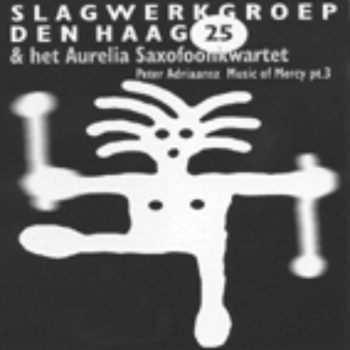No 9 Music of Mercy pt.3 (1997)
For 6 Percussion & Saxophone Quartet
Commissioned by: Percussion group The Hague & Aurelia Saxophone Quartet /Netherlands Fund for the Creation of Music
First Performance: Percussion group The Hague & Aurelia Saxophone Quartet, 1997, Paradiso, Amsterdam. Cond. Micha Hamel
Instrumentation: 6 Percussion & Saxophone Quartet.
Duration: 18’
Special Features: Performance requires samples of nature sounds.
![]() Score can be obtained through Donemus
Score can be obtained through Donemus
 Listen/Buy: Slagwerk Den Haag's website
Listen/Buy: Slagwerk Den Haag's website
Info/Program note:
Music of Mercy pt.3 derives its title from a quote by the English author G.K. Chesterton, which runs something like this: ‘if you leave a white fence alone for long enough, it will eventually become a black fence’. At the time of writing this piece, in 1997, I was already heavily preoccupied with trying to find an answer to the question: ‘how much does one really need to do (or conversely, how much can one just leave up to things ‘being as they are’)?’ In this way, like Chant Négatif before it, Music of Mercy attempts to deal with the relationship between Man and Nature – and the degree to which Man feels he must ‘act and alter’. Technically, it consisted of the ‘pursuit of the single event’: something which happens only once but is yet a structural component of the form.
The piece pursues these ideas in three movements, which gradually tilt in favor of Nature, but take the premise that ‘Mercy’ (one’s freedom - the ‘single event’) can only be achieved under hard rules. Hence the piece is severely constructed, but a good deal less heady than the preceding words might lead one to think.
The first two parts are both written according to the square root form: the first very active, with quick successions of heterogeneous materials, changing course with each attack of the Chinese Opera Gong; and the second very empty, filled with ‘small’ sounds and a lot of empty space. Both parts include a ‘single event’ at some point.
The short third part finally takes a very contrived notion which was prevalent in those years of New Complexity, namely the notion that ‘more layering creates more depth’ and proceeds to ridicule this idea through super-imposing six separate layers of information – all composed independently as separate ‘layers’, yet all together conjuring up no more than a kind of pastoral atmosphere with saxophone arpeggios, imitations of bird-calls, rolling thunder, nature samples of wind and rain and a far off tolling of bells.


